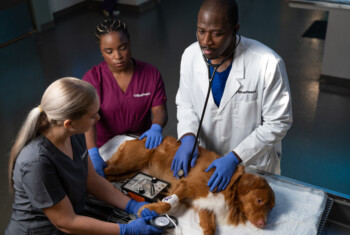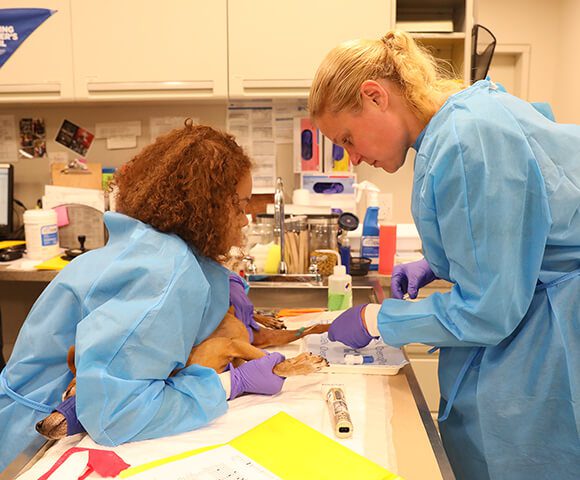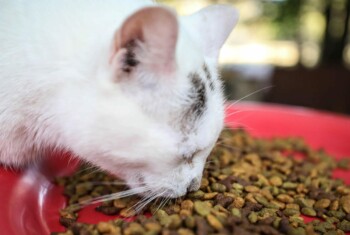What is diabetes mellitus?
Diabetes mellitus (DM) is a common endocrine disease in small animals characterized by a persistent increase in blood glucose (sugar). This happens when either the pancreas is unable to make insulin, the body is resistant to insulin, or both. Typically, pet owners first notice diabetes mellitus in dogs and cats as signs of intense thirst and increased urination.
The condition is treatable with a committed lifestyle change by both the pet and the owner: this includes twice daily injections of insulin, dietary adjustments, management of coexisting illnesses, weight management and regular veterinary follow-up.
Signs and symptoms of diabetes.
In the early stages of subclinical diabetes – where changes may still be mild and the pet is maintaining a stable weight – the diagnosis may be made by chance during routine lab work.
Common clinical signs that may indicate potential diabetes in your pet include:
- Increased volume of urination (polyuria)
- Increased thirst (polydipsia)
- Increased hunger (polyphagia) – often without weight gain
- Weight loss
- Lethargy and weakness
- Cataracts in dogs
- Abnormal gait and difficulty jumping in cats
Animals who are in the advanced stages of the disease, termed diabetic ketoacidosis (DKA), can have profound signs of illness, including hypovolemic shock (when blood plasma levels are too low), vomiting, depression, dehydration, electrolyte imbalance and loss of appetite.
Causes.
Diabetes causes persistent hyperglycemia (high blood sugar) due to the pancreas’ inability to produce the needed amount of insulin, a resistance to insulin by the body tissues secondary to another disease, or a combination of both.
Some of the most common risk factors for developing diabetes in both cats and dogs include:
- Insulin resistance secondary to obesity
- Hyperadrenocorticism (Cushing’s disease)
- Increased blood triglyceride levels
- Pancreatitis in dogs or cats
- Hypothyroidism
- Urinary, dental or skin infection
- Pregnant or unspayed females
- Certain medications, such as steroids
Getting a diagnosis.
If your pet exhibits signs of possible diabetes, see their primary care veterinarian for a physical exam and lab work. Some pets, especially cats, may develop stress hyperglycemia during visits to the vet, making diagnosis more challenging. But in these cases, repeating blood glucose tests or checking urine glucose on a non-stressed home sample can help reach a firm diagnosis.
To evaluate your pet for diabetes or other conditions, your veterinarian may recommend the following tests:
- Serum biochemistry, including triglycerides and electrolytes
- Complete blood count
- Urinalysis with urine culture or urine protein quantification if needed
- Thyroid levels
- Blood pressure
- Quantified pancreatitis testing (Spec cPL)
- Ketone levels for patients confirmed to have diabetes
- Venous blood gas analysis for sick patients with concern for DKA
- Fructosamine (glucose) levels in patients with questionable hyperglycemia
- Abdominal ultrasound by an imaging specialist or mobile ultrasonographer
Questions for your doctor.
When consulting with your pet’s veterinarian, consider asking questions like:
- What other conditions could my pet have that would make treatment challenging?
- How will my family’s lifestyle need to change to care for a diabetic pet?
- Can you discuss the cost of insulin, repeat visits for glucose curves and a prescription diet?
- What signs indicate that a regulated diabetic pet is becoming sick and needs veterinary care?
Treatment.
The primary goal when treating diabetes is to improve clinical signs while avoiding hypoglycemia. Absolute blood glucose numbers are not as critical in pets as in people with diabetes. Monitoring tools such as urine glucose strips, blood glucose curves, or the placement of a FreeStyle Libre device (which can provide immediate blood glucose readings using a smartphone) can help with the initial regulation period and any future adjustment periods.
At a minimum, treatment of diabetes in both cats and dogs will require twice daily injections with long-acting insulin after each meal. Most pets tolerate this well since the needle and the volume of insulin are very small. Depending on the type of insulin, pay close attention to storage, shelf life, reconstitution (rolling or shaking the vial) and the syringe size (U-40 or U-100) required for administration.
Your veterinarian will show you how to administer insulin to pets so you can do it at home.
Typically, dogs and cats diagnosed with diabetes benefit from being fed meals twice daily at approximately 12-hour intervals, synchronized with the duration of the long-acting insulin, which should also be administered every 12 hours, right after a meal. If your cat is a grazer, they may still be well managed without being restricted to two meals per day.
In about 25% of cats, diabetes can be temporary rather than life-long. For some cats, oral hypoglycemic agents such as Bexacat may be a reasonable initial alternative to insulin; this is specific to the case and should be discussed with your primary veterinarian.
Depending on how ill a pet is at the time of diagnosis – minimally affected and early onset vs. a hospitalized case with DKA – the initial treatment is aimed at correcting hydration, electrolytes, nausea, appetite, abdominal discomfort, any underlying infections and initiating insulin treatment.
Treatment for animals with DKA can be serious, require multiple days in the hospital, and is best performed with the continuous care of veterinary specialists in internal medicine or critical care in a 24/7 hospital such as BluePearl.
The American Animal Hospital Association recommends the following in treating and managing diabetes in dogs and cats:
- Once a long-acting insulin is chosen, an in-hospital blood glucose curve is recommended in one to two weeks to assess the efficacy of treatment and make any initial adjustments. Adjustments should not be made without the direction of a veterinarian as both under- and overdosing can have dangerous consequences.
- Every time an adjustment is made by your veterinarian, another blood glucose curve should be taken in one to two weeks.
- Once a steady state is reached, even in a well-controlled diabetic, glucose curves are recommended every three months, if clinical signs change, or if there is suspicion of hypoglycemia, a dangerously low blood sugar that can result in weakness, stumbling/acting drunk, lethargy and seizures.
Prevention.
Optimizing body weight, preventing obesity and promoting an active lifestyle are as important in cats and dogs as they are in people. Pets should be fed a quality-controlled diet from leading manufacturers (such as Hill’s, Royal Canin or Purina) without fatty, rich treats or frequent diet changes, which can trigger pancreatitis.
If you notice any changes to your pet’s thirst or urination habits, visiting your veterinarian to obtain an early diagnosis is vital. Proactively treating dental disease, urinary or skin infections, adrenal or thyroid disease and limiting the use of steroids to only the most necessary are also critical in preventing diabetes.
Prognosis.
Diabetes is a life-long condition, especially in dogs (a small percentage of cats go into remission), requiring a lifestyle change for you and your pet. When working with your pet’s healthcare team, it’s important to understand the illness and cost of care; don’t hesitate to create an open dialogue about the caregiver burden this disease can cause.
Progression from diabetes to a critical state of diabetic ketoacidosis can lead to hospitalization. But with diligent care and follow-up visits, many diabetic pets can live a good quality of life.
For additional information on diabetes, refer to the AVMA’s pet owner resource page.


